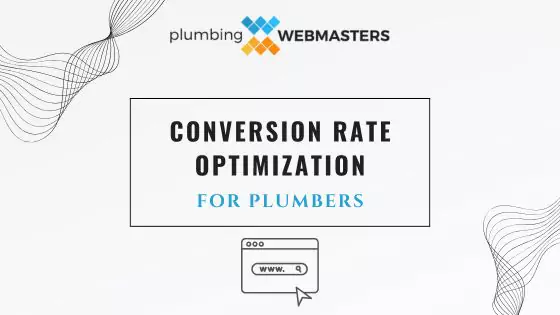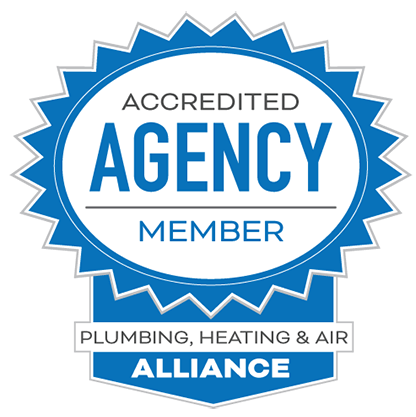Conversion rate optimization for plumbers increases the number of website visitors who complete an action, such as filling out a contact form or clicking a phone number button.
For local plumbers, website conversions are pivotal as they drive qualified plumbing leads to your business through organic SEO, Google Maps optimization, and AI Overviews.
If your plumbing website is not converting at an acceptable rate, it may be time to evaluate how optimized it is for conversions.
I founded HVAC-Plumber SEO Webmasters in 2011, and over the past 14+ years, I’ve learned that attracting website visitors through Google and other sources is only as good as your website conversion rate.
Sending prospects to a website that doesn’t convert wastes your marketing resources and undermines your broader campaign.
In the following guide, I’ll outline how to apply conversion rate optimization (CRO) for plumbers to your business website in 2025.

Key Takeaways for Plumbing CRO
- Invest in a professional plumbing website
- Implement engaging calls-to-action (CTAs)
- Highlight your company’s expertise and experience
- Ensure fast loading times and easy navigation
- Track your conversions
Benchmarking a “Good” Plumbing Conversion Rate
The average website conversion rate is between 2% and 5%, with 5% or better considered “good.”
So, for every 100 visitors to your plumbing business website, between 2 and 5 will complete an action like filling out a contact form or clicking a phone number button.
Website Conversion Rate Variables
Different traffic sources impact conversion rates, regardless of how optimized your website is for lead generation.
For example, with all things equal, visitors who find your site through an organic Google search are far likelier to convert than those who click on your Google PPC ad.
Other variables also influence conversion rates, which I will list below:
Traffic Source
As I mentioned, traffic sources impact conversions, and organic SEO traffic has the highest conversion rate.
Google Maps clicks to your website also have very high conversion rates, with some studies showing it as up to 80%.
Traffic from plumbing PPC ads typically have low conversion rates, as much as 21x lower than organic visitors.

Website Speed
Fast-loading websites naturally convert better than slow ones, and the definition of “slow” has changed significantly over the years.
Today’s website users expect any website to load within 3 seconds, but those that load within 1-second garner the highest conversion rates.
Working with an experienced web developer can enhance your site speed, as can WordPress plugins like WPRocket (for those using WordPress).
Content Type (Blogs vs. Service Pages)
A lesser-known conversion factor is content type (i.e., blog posts vs. location and service pages), which comes into play for most plumbing companies.
Unfortunately, the plumbing SEO industry is ripe with agencies who publish “blog posts” for their clients to drive up traffic without conversions.
Google’s Helpful Content Update warns against “producing lots of content on different topics in hopes that some of it might perform well in search results” as this rarely provides unique value to the user.
As a result, plumbing blog posts can reduce rankings and conversions for your priority keywords while driving vanity traffic for zero-conversion terms.
Content Relevance
Content relevance is another factor impacting conversions, which can also be characterized as “satisfying user intent.”
If your prospect seeks a water heater repair in Denver, CO, a page about general plumbing will not satisfy their unique intent.
While organic Google results are unlikely to produce these relevance overlaps because the algorithm ranks relevant content highest, other sources like paid ads can prompt this issue.
As a result, ensure that the website page you are driving users to matches their intent.
Plumbing Conversion Rate Optimization Fundamentals
As someone with an agency that has produced thousands of plumbing company websites, I know the fundamentals that serve as the baseline for website conversions.
There is no need for a “trial and error” approach when you can learn directly from my 14+ years of first-hand experience with website design.
Below, I will outline conversion rate optimization fundamentals for plumbing companies in 2025:
Calls-To-Action (CTAs)
A call-to-action is a button or statement encouraging the website visitor to take a specific action.
A plumber CTA might be a button that links to a contact form submission or a clickable phone number that allows mobile visitors to call your business number directly from the website.
Without CTAs, conversions will be minimal, so ensure you understand CTAs and how to implement them into your design.

Company Branding
An overlooked conversion principle for plumbing companies is branding, as visitors won’t invest in an unknown entity.
Consequently, displaying your company name, logo, phone number, and address is essential for conversions.
It also helps you link to your other digital assets, such as your Google Business Profile, Facebook Business Page, and YouTube channel.
Site Security
A website SSL certificate is essential to driving website conversions in 2025. Any non-secure website (HTTP) will show a warning in most browsers.
As a result, users who navigate to a non-secure website are unlikely to see the content and, therefore, will never convert.
Most hosting providers make it easy for plumbers to add an SSL certificate to their domain, but you can work with a professional web design agency for assistance.
Social Proof
Content that showcases your real-world value is the most beneficial to conversions on a plumbing business website.
Yes, SEO optimizations are necessary, but showing images of your recent jobs, your plumbing license number, your reviews, and award badges will drive actions from visitors.
At least some of your social proof must be visible “above the fold” on mobile or desktop browsers without having to scroll down.
I recommend using a reviews slider plugin that showcases Google and Yelp reviews through an API so users can trust the source.

Website Accessibility
Another CRO fundamental for plumbing contractors is website accessibility, which means people can quickly access your website and read and engage with the content.
Factors like text size, font, and user navigation all affect accessibility, and experienced designers understand how to make this a priority.
Accessibility must expand across all device types, from mobile to desktop and tablet and everything in between. Responsive web design (RWD) allows websites to adapt to the device they are accessed.
Tracking Plumbing Website Conversions
Tracking an entire conversion funnel is not always straightforward, as a visitor’s origin can span various mediums, from organic search to social media marketing.
However, tracking conversion rates as much as possible is crucial to improve the pages or sections with lower conversion rates.
Below, I will list some of the ways you can track plumbing website conversions in 2025:
Google Analytics
Google Analytics 4 allows plumbing companies to mark specific events as conversions, which can then be tracked and evaluated through the tolls native conversion report.
Visits to a Contact Us or Thank You page are easy to mark as conversions because their URL is already tracked within the GA4 platform.
Plumbers can also create custom events for specific CTA buttons, including click-to-call phone numbers.
Google Tag Manager
More advanced conversions like form field interactions require Google Tag Manager integration with GA4.
GTM is also useful for “conditional conversions,” which require the user to perform prerequisite events before counting their action as a conversion.
Properly setting up Google Tag Manager is more complex than tracking conversions straight from the GA4 platform, so it will likely require professional assistance.
Heat Mapping
Plumbers looking for more granular conversion data may want to invest in heat mapping software that displays visitors’ website behavior in color-coded format.
For example, clicking on a specific part of a webpage will showcase red dots, while scrolling to a different page section will showcase blue dots.
Heat maps capture information beyond the scope of Google Analytics or Google Tag Manager, allowing plumbing web designers to pinpoint the precise areas for improvement.
Tips to Improve Your Plumbing Website Conversion Rates
There are many things local plumbers can do to increase their website conversion rates. Over my 14+ years of first-hand experience working with plumbing companies, I have the data and expertise to understand what tweaks help boost conversions and, ultimately, plumbing leads.
Enhance Calls-To-Action (CTAs)
A call-to-action, or CTA, is more than just a button that says, “Click here.” It is a psychological mechanism that encourages website visitors to take action.
As relayed in my plumbing marketing statistics, red CTA buttons outperformed other colors in research.
The placement of CTAs is also proven to impact their click-through rates, as those visible “above the fold” foster the most engagement.
Users who have to scroll down your pages to find a call-to-action are less likely to click them than if they are embedded into your website header.
Demonstrate E-E-A-T
My recent podcast outlines the importance of expertise, experience, authority, and trust (E-E-A-T) to Google rankings in 2025, but its impact expands to conversion rates.
Users who feel your plumbing company is an expert with first-hand experience and authority and can be trusted are far more likely to convert.
You can use a tool like DataPins to enhance your website’s E-E-A-T by showcasing recent plumbing jobs.
You can also include your plumbing license number, award badges, and original photos of your truck and staff.
Integrate Reviews on Your Website
While reviews are also part of E-E-A-T, they are worthy of their own category for conversion rate optimization.
Many plumbers make the mistake of either not showing reviews on their websites or adding screenshot images of Google or Yelp reviews to their websites.
Images can be doctored easily, especially in the era of artificial intelligence and deepfakes.
Consequently, it’s essential to use a review slider plugin that pulls your reviews through API from credible third-party platforms like Google, Yelp, and Facebook.
Reduce “Friction” on Contact Forms
Website visitors are less likely to complete contact forms with more than three fields. Plumbing companies sometimes purposely add four or more fields to weed out bad leads.
Adding more fields to your contact form is known as “friction” because it generally increases the quality of your leads.
However, this comes at the expense of some qualified leads slipping through the cracks.
Plumbing companies that invest in organic SEO should reduce friction on their contact forms since most SEO leads are high-quality and do not require additional filtering.
Embed YouTube Videos on Your Website
Embedding videos on your plumbing website pages can increase conversions by 86%.
I recommend embedding YouTube videos as these are eligible to rank in Google SERPs and can send more traffic to your website from multiple sources.
As a local plumber, you can create video content using your smartphone and a simple editing tool like iMovie.
You can create an introduction video with your staff and specific videos for each service you provide.
Showcase Unique Value Propositions (UVPs)
Visitors who view your company as a run-of-the-mill plumbing company are less likely to take action.
If they see your website as spammy or untrustworthy, they will likely exit it quickly.
You need unique value propositions (UVPs) to stand out from competitors.
Examples of UVPs for plumbers include:
- Local Expertise
- Real-Time Trust Signals
- Fast and Easy Scheduling
- Emergency Readiness
- Transparent Pricing
- Licensed & Insured Plumbers
- Eco-Friendly Solutions
- SEO-Driven Design
Prioritize User Experience
Even with proper UVPs and CTAs, low conversion rates can still result from poor user experience (UX).
Factors like website navigation (desktop, mobile, and all devices) heavily impact your final conversion rate percentages.
Ensure your plumbing website design is crafted specifically for your users and is easy to navigate on mobile devices with smaller screen sizes.
An experienced plumbing web designer is less concerned with “wow factor” design elements and more about ease of use, leading to conversions.
Final Thoughts on Conversion Rate Optimization
As the founder and CEO of Plumbing Webmasters – a digital marketing agency for plumbers, my agency has designed thousands of websites for local contractors.
While driving visitors to the website from Google, AI, and other sources is essential, none of it matters if the website does not convert at an acceptable rate.
While the average website conversion rate is between 2% and 5%, my clients’ websites are optimized to outperform these averages.
My experienced web design team has honed their skills in the plumbing website space, where nuances make all the difference in conversions.
My agency prioritizes user experience, navigation, CTA placement, and E-E-A-T signals to generate legitimate prospects for your business.
To discuss my 14+ years of first-hand experience with conversion rate optimization for plumbers, call my personal cell phone at (877) 388-9884.






